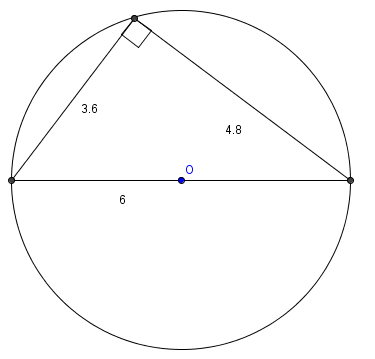Difference between revisions of "2007 AMC 12A Problems/Problem 10"
(→Problem) |
(→Solution) |
||
| Line 7: | Line 7: | ||
[[Image:2007_AMC12A-10.png]] | [[Image:2007_AMC12A-10.png]] | ||
| − | Since 3-4-5 is a [[Pythagorean triple]], the triangle is a [[right triangle]]. Since | + | Since 3-4-5 is a [[Pythagorean triple]], the triangle is a [[right triangle]]. Since the hypotenuse is a [[diameter]] of the [[circumcircle]], the hypotenuse is <math>2r = 6</math>. Then the other legs are <math>\frac{24}5=4.8</math> and <math>\frac{18}5=3.6</math>. The area is <math>\frac{4.8 \cdot 3.6}2 = 8.64\ \mathrm{(A)}</math> |
==See also== | ==See also== | ||
Revision as of 09:14, 19 October 2007
Problem
A triangle with side lengths in the ratio ![]() is inscribed in a circle with radius 3. What s the area of the triangle?
is inscribed in a circle with radius 3. What s the area of the triangle?
![]()
Solution
Since 3-4-5 is a Pythagorean triple, the triangle is a right triangle. Since the hypotenuse is a diameter of the circumcircle, the hypotenuse is ![]() . Then the other legs are
. Then the other legs are ![]() and
and ![]() . The area is
. The area is ![]()
See also
| 2007 AMC 12A (Problems • Answer Key • Resources) | |
| Preceded by Problem 9 |
Followed by Problem 11 |
| 1 • 2 • 3 • 4 • 5 • 6 • 7 • 8 • 9 • 10 • 11 • 12 • 13 • 14 • 15 • 16 • 17 • 18 • 19 • 20 • 21 • 22 • 23 • 24 • 25 | |
| All AMC 12 Problems and Solutions | |










